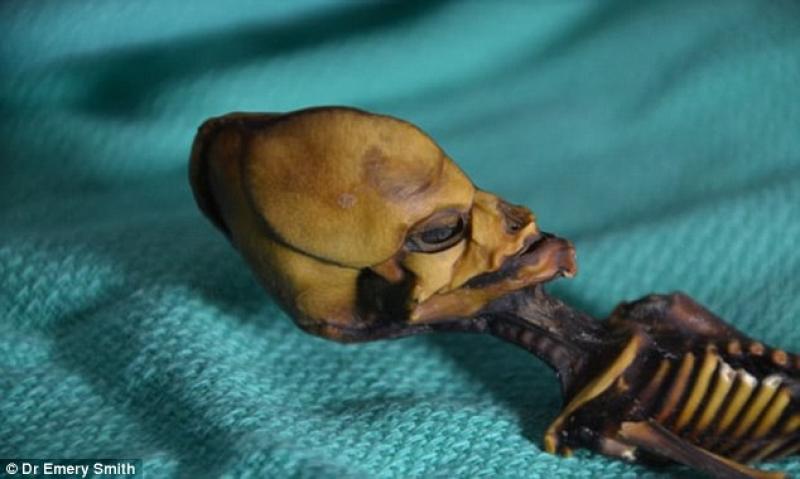No, It's Not an Alien — Here's What That Tiny, Pointy-Headed Skeleton Really Is


A tiny, pointy-headed skeleton that fits in the palm of a hand isn't an alien, despite conspiracy theories that have circulated for years.
The skeleton, with a dramatically elongated skull and an underdeveloped jaw and face, was uncovered in Chile's Atacama Desert in 2003, and mystified scientists when it was first found.
Research published in 2013 offered some clues about the skeleton's bizarre appearance, but five additional years of genetic analysis have provided even more answers. Examination of the skeleton's entire genome revealed that it was Chilean and female, and that its misshapen skull and other deformities might be linked to a host of genetic mutations that affect bone development. Together, those mutations shaped an array of abnormalities that gave the remains an alien-like form.
Though the skeleton is the size of a 22-week-old fetus, it was initially thought to be a 6- to 8-year-old child with severe deformities. Nearly a decade later, a highly detailed analysis — including X-rays, computed tomography (CT) scans and DNA sequencing — showed that it was a fetus (and that it was definitely human).
It's hard to tell how old the skeleton is just by looking at it, but prior examinations found it to be about 40 years old, scientists explained in a new study. Despite the skeleton's minuscule size, previous analysis cast doubt on whether it was a fetus because its "advanced bone age" more closely resembled that of a young child, particularly in the structure of the skeleton's skull, with sutures that were already fused.
But that feature was a byproduct of a genetic mutation — one of many that caused its numerous skeletal deformities. And, in fact, the premature fusing of skull plates in the fetus is what gave the skull its pointed shape, the researchers reported.
The scientists extracted DNA from one of the skeleton's ribs — another anomaly that previously had fueled speculation about alien origins, as there were 10 pairs, rather than the 12 normally found in humans.
However, alien hunters will likely be disappointed to hear that "the specimen is shown here to have a purely earthly origin," the study authors reported.
Genetic anomalies, not extraterrestrial DNA
While the scientists found no evidence of alien DNA, they did find mutations in seven of the fetus's genes: COL1A1, COL2A1, KMT2D, FLNB, ATR, TRIP11 and PCNT. Mutations in these genes are known to play roles in premature joint fusion, abnormalities in rib development, malformed skulls, and diseases that inhibit the development of bone and cartilage, according to the study.
Taken together, the mutations expressed by these genes would explain all of the fetus's skeletal abnormalities, the scientists concluded. However, finding so many mutations that specifically affect skeletal development is unusual; in fact, it's never been reported before, and it is unknown what triggered this cascade of mutations, study lead author Garry Nolan, a professor of microbiology and immunology at Stanford University, told Live Science in an email.

Credit: Bhattacharya S et al. 2018
As bizarre as this skeleton may appear, it isn't the first example of remains that look mostly human but nevertheless invite comparisons to popular images of creatures from science fiction.
In 1999, excavations in a 1,000-year-old cemetery in Mexico yielded 13 human skeletons — many of them children — with skulls that were stretched and pointed in the back, bearing a distinctly alien appearance. But researchers determined that the skulls' unusual shapes stemmed from cultural practices that deliberately deformed the bone, similar to those seen in pre-Hispanic cultures in Central America.
And 14 elongated, alien-like skulls in Bavarian graves dating to 1,500 years ago also were traced to cultural practices of cranial shaping, this time in tribes from southeastern Europe, Live Science previously reported .
However, five so-called "alien mummies" from Peru — mummified humanoids with three-fingered hands — were widely denounced by experts as fabrications , perhaps even cobbled together from looted body parts belonging to real human remains. [ In Photos: 'Alien' Skulls Reveal Odd, Ancient Tradition ]
Genes working together
The bigger story is not about the skeleton's debunked "alien" origins but what its analysis reveals about how genes shape our skeletons as they develop and grow, and how they interact with each other to do so — successfully or not, Nolan told Live Science in an email.
"The era of single gene/single disease is just about over — it's now time to look at the more subtle effects when genes interact," Nolan wrote. "In isolation, a gene might have no effect ... but combined with other genes, the outcomes can be dramatic."
The idea of gene collaboration is not new to geneticists; it has been well studied for years in models derived from fruit flies, plants and yeasts, Nolan said. But now, researchers are compiling enough data to understand these genetic interactions in humans, and are exploring how they affect our biology.
https://www.livescience.com/62097-tiny-skeleton-not-alien.html





An alien the size of a dollar bill?
I also found it a little amusing that some people evidently thought the fact that it had 10 pairs of ribs instead of 12 indicated it may have come from another world. (Not taking into account the possibility that aliens from other worlds might not have any ribs at all.
Popular imagination has created aliens in a version of our own image, often with elongated heads that seemingly indicate superior intelligence. Well except for Flash Gordon serials and the like. They couldn't afford special effects so they just made aliens into human beings with elaborate costumes.
Well poo. I like that it might have been an alien.
Lol, well you still can, just ignore facts, evidence, logic and use faith to support your belief